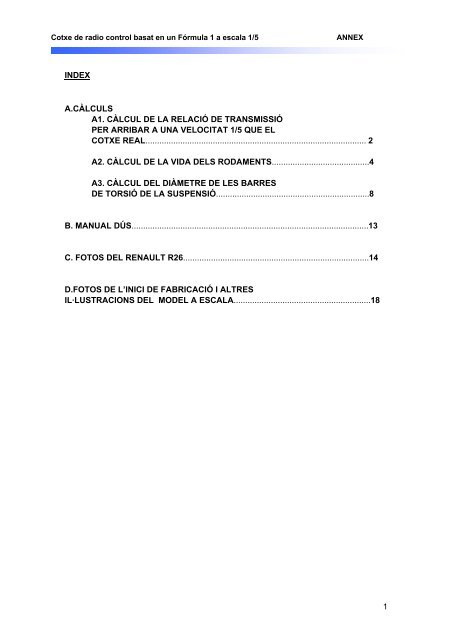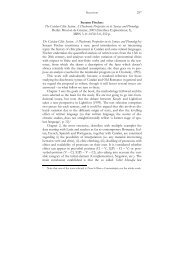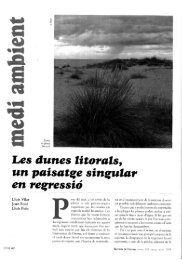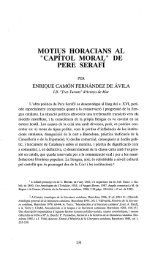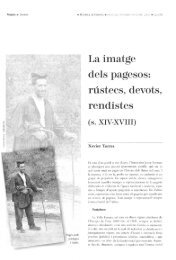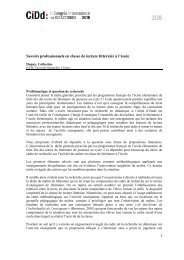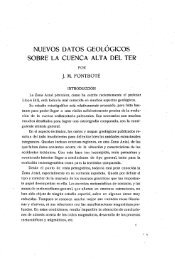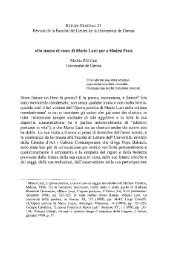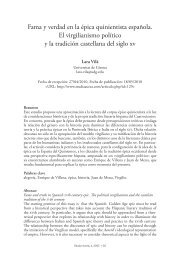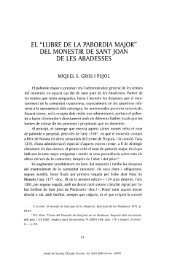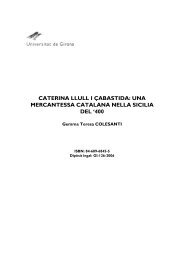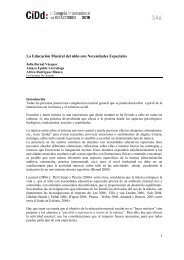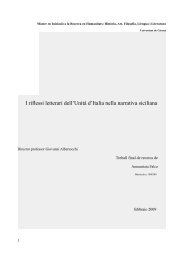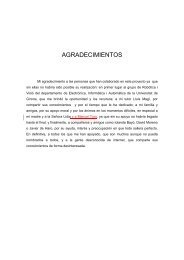1 index a.càlculs a1. càlcul de la relació de transmissió per arribar a ...
1 index a.càlculs a1. càlcul de la relació de transmissió per arribar a ...
1 index a.càlculs a1. càlcul de la relació de transmissió per arribar a ...
You also want an ePaper? Increase the reach of your titles
YUMPU automatically turns print PDFs into web optimized ePapers that Google loves.
Cotxe <strong>de</strong> radio control basat en un Fórmu<strong>la</strong> 1 a esca<strong>la</strong> 1/5 ANNEX<br />
INDEX<br />
A.CÀLCULS<br />
A1. CÀLCUL DE LA RELACIÓ DE TRANSMISSIÓ<br />
PER ARRIBAR A UNA VELOCITAT 1/5 QUE EL<br />
COTXE REAL............................................................................................... 2<br />
A2. CÀLCUL DE LA VIDA DELS RODAMENTS..........................................4<br />
A3. CÀLCUL DEL DIÀMETRE DE LES BARRES<br />
DE TORSIÓ DE LA SUSPENSIÓ..................................................................8<br />
B. MANUAL DÚS......................................................................................................13<br />
C. FOTOS DEL RENAULT R26................................................................................14<br />
D.FOTOS DE L’INICI DE FABRICACIÓ I ALTRES<br />
IL·LUSTRACIONS DEL MODEL A ESCALA...........................................................18<br />
1
Cotxe <strong>de</strong> radio control basat en un Fórmu<strong>la</strong> 1 a esca<strong>la</strong> 1/5 A.CÀLCULS<br />
A1. CÀLCUL DE LA RELACIÓ DE TRANSMISSIÓ PER ARRIBAR A UNA<br />
VELOCITAT 1/5 QUE EL COTXE REAL<br />
Les prestacions <strong>de</strong>l motor que interessen <strong>per</strong> aquest el <strong>càlcul</strong> són :<br />
Règim <strong>de</strong> gir pràctic 4.000 – 34.000 rpm<br />
Potència 1 2,8 CV a 28.000 rpm<br />
Parell 3 0,74 m·N a 23.500 rpm<br />
La <strong>transmissió</strong> és directe, i no hi ha canvi <strong>de</strong> velocitats. Per tant, es calcu<strong>la</strong>rà <strong>la</strong> re<strong>la</strong>ció<br />
<strong>de</strong> <strong>transmissió</strong> a partir <strong>de</strong> <strong>la</strong> velocitat màxima <strong>de</strong>l cotxe.<br />
La velocitat màxima que agafa un F1 en un circuit és <strong>de</strong> 370 km/h. La velocitat<br />
si que es pot passar a esca<strong>la</strong>, i <strong>per</strong> tant serà:<br />
La re<strong>la</strong>ció <strong>de</strong> <strong>transmissió</strong> if<br />
n<br />
r<br />
v<br />
370 _ km / h·<br />
1 = 74 _ km / h<br />
5<br />
74 _ km / h = 20,<br />
55 _ m / s<br />
motor<br />
ro<strong>de</strong>s<br />
max<br />
= 34.<br />
000 _ rpm⎫<br />
⎪<br />
= 132 _ mm ⎬i<br />
= 20,<br />
55 _ m / s ⎪<br />
⎭<br />
f<br />
=<br />
0,<br />
085<br />
Una possible re<strong>la</strong>ció <strong>de</strong> <strong>transmissió</strong> amb combinant els engranatges <strong>per</strong>tinents<br />
seria:<br />
14 10 10<br />
if = · · = 0,<br />
085<br />
42 28 14<br />
Els engranatges necessaris <strong>per</strong> aconseguir una velocitat <strong>de</strong> 74 km/h es <strong>de</strong>tallen a<br />
continuació:<br />
Engranatge zi rpm eix etapa i<br />
Pinyó campana embragatge 14 34.000 rpm<br />
Corona<br />
Pinyó atac cònic<br />
42<br />
10<br />
11.333 rpm<br />
Corona cònica<br />
Politja motriu<br />
28<br />
10<br />
4.048 rpm<br />
Politja conduïda 14 2.892 rpm<br />
1 Da<strong>de</strong>s aproxima<strong>de</strong>s.<br />
2
Cotxe <strong>de</strong> radio control basat en un Fórmu<strong>la</strong> 1 a esca<strong>la</strong> 1/5 A.CÀLCULS<br />
Tots els engranatges i politges que hi ha en <strong>la</strong> <strong>transmissió</strong> provenen <strong>de</strong> RC o<br />
components industrials, i <strong>per</strong> tant, no es calcu<strong>la</strong>rà <strong>la</strong> seva resistència ni <strong>de</strong>sgast.<br />
3
Cotxe <strong>de</strong> radio control basat en un Fórmu<strong>la</strong> 1 a esca<strong>la</strong> 1/5 A.CÀLCULS<br />
A2. CÀLCUL DE LA VIDA DELS RODAMENTS<br />
Els rodaments calcu<strong>la</strong>ts son els <strong>de</strong> <strong>la</strong> <strong>transmissió</strong> <strong>per</strong>què son els més sol·licitats. La<br />
resta <strong>de</strong> rodaments s’han escollit <strong>per</strong> dimensions en funció <strong>de</strong> <strong>la</strong> disponibilitat<br />
comercial.<br />
1 4<br />
RY1<br />
RX1<br />
RX2<br />
RX4<br />
RX3<br />
RY2 RZ2<br />
2<br />
RY3<br />
RY4<br />
RZ4<br />
Fig. 1 Tall <strong>de</strong> <strong>la</strong> <strong>transmissió</strong><br />
3<br />
RX5<br />
RX6<br />
4<br />
5<br />
6
Cotxe <strong>de</strong> radio control basat en un Fórmu<strong>la</strong> 1 a esca<strong>la</strong> 1/5 A.CÀLCULS<br />
Càlcul <strong>de</strong> les reaccions sobre els rodaments<br />
Amb les dimensions <strong>de</strong>ls elements i l’entrada <strong>de</strong> parell que prové <strong>de</strong>l motor s’ha<br />
calcu<strong>la</strong>t les forces que actuen sobre els rodaments:<br />
Etapa 1<br />
N Rodament RX RY RZ<br />
1 Rígid radial boles 9x17x4 104,3 134,7 0<br />
2 Rígid radial boles 9x17x4 45,5 439,6 91,54<br />
Etapa 2<br />
N Rodament RX RY RZ<br />
3 Agulles amb caixa ext.<br />
4x8x8<br />
497,8 109,5 0<br />
4 Rígid radial boles 4x16x5 361,7 199,0 42,7<br />
Etapa 3<br />
N Rodament RX RY RZ<br />
5 Rígid radial boles 15x21x5 384 0 0<br />
6 Rígid radial boles 15x21x5 384 0 0<br />
5
Cotxe <strong>de</strong> radio control basat en un Fórmu<strong>la</strong> 1 a esca<strong>la</strong> 1/5 A.CÀLCULS<br />
Càlcul <strong>de</strong> <strong>la</strong> resistència i <strong>la</strong> vida <strong>de</strong>ls rodaments<br />
Càlcul <strong>de</strong>ls rodaments <strong>de</strong> <strong>la</strong> <strong>transmissió</strong> a partir <strong>de</strong> les reaccions troba<strong>de</strong>s abans.<br />
S’utilitzaran les fórmules següents pel <strong>càlcul</strong> <strong>de</strong> <strong>la</strong> vida <strong>de</strong>l rodament:<br />
Fa<br />
P = Fr → ≤ e<br />
Fr<br />
Fa<br />
P = 0,<br />
5·<br />
Fr + Y·<br />
Fa → > e<br />
Fr<br />
e → paràmetre donat pel catàleg <strong>de</strong>ls rodaments.<br />
i<br />
⎛ C ⎞<br />
6<br />
L = ⎜ ⎟ = cicles·<br />
10<br />
⎝ P ⎠<br />
i → 3 <strong>per</strong> rodaments <strong>de</strong> boles i 3,33 <strong>per</strong> rodaments d'agulles.<br />
La resistència estàtica es calcu<strong>la</strong>rà comparant P amb C0.<br />
Etapa 1<br />
Hi ha dos rodaments iguals, <strong>per</strong> tant, es calcu<strong>la</strong> el més <strong>de</strong>sfavorable:<br />
2 Rígid radial boles 9x17x4 Fr = 442 Fa = 91,5<br />
C=1430 Co=640<br />
Resultat<br />
Vida 5790 minuts<br />
Estàtic Vàlid<br />
Etapa 2<br />
En aquesta etapa es calcu<strong>la</strong>ran els dos coixinets <strong>de</strong> l’eix ja que son diferents:<br />
3 Agulles amb caixa ext. 4x8x8 Fr = 412,8 Fa = 0<br />
C=1780 Co=1270<br />
Resultat<br />
Vida 19000 minuts<br />
Estàtic Vàlid<br />
4 Rígid radial boles 4x16x5 Fr = 509,7 Fa = 42,7<br />
Resultat<br />
Vida 9278 minuts<br />
Estàtic Vàlid<br />
Etapa 3<br />
C=1301 Co=488<br />
6
Cotxe <strong>de</strong> radio control basat en un Fórmu<strong>la</strong> 1 a esca<strong>la</strong> 1/5 A.CÀLCULS<br />
Els dos rodaments estan sotmesos a <strong>la</strong> mateixa càrrega i son iguals:<br />
5 Rígid radial boles 15x21x5 Fr = 384 Fa = 0<br />
C=9900 Co=6300<br />
Resultat<br />
Vida 5925311 minuts<br />
Estàtic Vàlid<br />
7
Cotxe <strong>de</strong> radio control basat en un Fórmu<strong>la</strong> 1 a esca<strong>la</strong> 1/5 A.CÀLCULS<br />
A3. CÀLCUL DEL DIAMETRE LES BARRES DE TORSIÓ DE LA SUSPENSIÓ<br />
Per dur a terme aquest <strong>càlcul</strong> s’ha estimat <strong>la</strong> força que fa cada roda en diferents<br />
situacions dinàmiques:<br />
<br />
Estàtic<br />
m·g<br />
R D<br />
R<br />
R·mu<br />
R·mu<br />
R<br />
Frenada<br />
m·g<br />
m·a<br />
Corba<br />
m·an<br />
m·g<br />
D<br />
D·mu<br />
D<br />
D·mu<br />
8
Cotxe <strong>de</strong> radio control basat en un Fórmu<strong>la</strong> 1 a esca<strong>la</strong> 1/5 A.CÀLCULS<br />
En els <strong><strong>càlcul</strong>s</strong> s’ha suposat un coeficient <strong>de</strong> fricció (mu) = 1 i una m = 5kg. Les forces<br />
màximes aproxima<strong>de</strong>s que fa cada roda segons aquestes hipòtesis son les següents:<br />
Min Max<br />
Davant 11,5 N 20 N<br />
Darrera 13 N 23,5 N<br />
Suspensió davantera<br />
Càlcul <strong>de</strong> les forces a <strong>la</strong> barra pushrod segons les hipòtesis anteriors<br />
A partir <strong>de</strong> <strong>la</strong> força vertical (20N) i <strong>la</strong>teral (20N) <strong>de</strong> <strong>la</strong> roda es calcu<strong>la</strong> <strong>la</strong> força <strong>de</strong> <strong>la</strong><br />
barra push-rod (Fc). L’esquema mostra les forces que intervenen en <strong>la</strong> boixa. S’ha<br />
<strong>de</strong>spreciat l’angle king-pin <strong>per</strong> simplificar el <strong>càlcul</strong> ja que <strong>la</strong> seva influència és petita.<br />
Fx = 0)<br />
Fy = 0)<br />
Fz = 0)<br />
Mz(<br />
b)<br />
= 0)<br />
Mx(<br />
b)<br />
= 0)<br />
- Fa·cos83º<br />
−Fb·cos84º<br />
−Fc·cos50º·cos11º<br />
= −20·cos9º<br />
−<br />
20·sin<br />
81º<br />
- Fa·sin<br />
83º<br />
−Fb·sin<br />
84º<br />
−Fc·cos11º·sin<br />
50º<br />
= 20·sin<br />
9º<br />
−<br />
20·cos81º<br />
- Fax + Fc·cos50º·sin11º<br />
+ Fbx = 0<br />
+ Fa·sin<br />
83º<br />
( 44,<br />
9)<br />
+ Fc·cos11º·sin<br />
50º<br />
( 34,<br />
9)<br />
=<br />
−<br />
20·sin<br />
9º<br />
( 83,<br />
2)<br />
Fax(<br />
44,<br />
9)<br />
− Fc·cos50º·sin11º<br />
( 34,<br />
9)<br />
= 0<br />
Fa = 54,<br />
67N<br />
Fax = 3,<br />
8N<br />
Fb = 41N<br />
Fc = 38N<br />
Fbx = 1,<br />
1N<br />
La força que transmet <strong>la</strong> barra push-rod és <strong>de</strong> 38 N.<br />
+<br />
20sin<br />
81º<br />
( 93,<br />
2)<br />
La força Fc és <strong>la</strong> que transmet <strong>la</strong> barra push-rod al ba<strong>la</strong>ncí, i <strong>per</strong> tant, crea el moment<br />
que ha <strong>de</strong> contrarestar <strong>la</strong> barra <strong>de</strong> torsió. Aquest moment varia amb el moviment <strong>de</strong> <strong>la</strong><br />
barra, <strong>de</strong>gut a <strong>la</strong> variació <strong>de</strong> l’angle entre el braç <strong>de</strong> pa<strong>la</strong>nca i <strong>la</strong> força. Però, com que<br />
el <strong>de</strong>sp<strong>la</strong>çament és tant petit, es pot aproximar que el moment és proporcional a Fc.<br />
9
Cotxe <strong>de</strong> radio control basat en un Fórmu<strong>la</strong> 1 a esca<strong>la</strong> 1/5 A.CÀLCULS<br />
D’aquesta manera es pot assegurar que tant <strong>la</strong> F màxima com <strong>la</strong> F mínima estima<strong>de</strong>s<br />
es complirà. Amb el programa MatLab s’ha simu<strong>la</strong>t el moviment <strong>de</strong> <strong>la</strong> suspensió <strong>per</strong><br />
<strong>de</strong>terminar l’angle <strong>de</strong> <strong>de</strong>sp<strong>la</strong>çament <strong>de</strong>l ba<strong>la</strong>ncí en funció <strong>de</strong> <strong>la</strong> variació d’alçada.<br />
Moviment <strong>de</strong> <strong>la</strong> suspensió davantera calcu<strong>la</strong>da<br />
amb MatLab<br />
Moment <strong>de</strong> <strong>la</strong> barra <strong>de</strong> torsió [m·N] respecte<br />
l’angle girat <strong>de</strong>l ba<strong>la</strong>ncí (º).<br />
Càlcul <strong>de</strong>l diàmetre d <strong>de</strong> <strong>la</strong> barra <strong>per</strong> obtenir <strong>la</strong> rigi<strong>de</strong>sa <strong>de</strong>sitjada<br />
Material Acer <strong>per</strong> molles 1.0904<br />
Sut=1320 MPa Sy=1130 MPa G=79300 MPa<br />
10
Cotxe <strong>de</strong> radio control basat en un Fórmu<strong>la</strong> 1 a esca<strong>la</strong> 1/5 A.CÀLCULS<br />
Barra torsió<br />
davant<br />
38·cos11º·sin<br />
59 = 32N<br />
32·<br />
10mm<br />
= 320mmN<br />
l = 36mm<br />
T = 320mN<br />
583,<br />
6·<br />
T·<br />
l<br />
φ = → d = 1,<br />
33mm<br />
4<br />
G·<br />
d<br />
Càlcul <strong>de</strong> resistència<br />
Fatiga<br />
320 − 0<br />
Tm = = 160mmN<br />
2<br />
Ssu = 0,67·Sut = 884MPa<br />
1 16<br />
Goodman → =<br />
n π·<br />
d<br />
Estàtic<br />
16·T<br />
τ = = 692MPa<br />
→<br />
3<br />
π · d<br />
3<br />
⎛ kf · Ma ⎞ ⎛ Tm ⎞<br />
· ⎜ ⎟ · ⎜ ⎟<br />
⎝ Sse ⎠ ⎝ Ssu ⎠<br />
ne<br />
=<br />
1130<br />
692<br />
2<br />
=<br />
1,<br />
63<br />
2<br />
→ n =<br />
El diàmetre <strong>de</strong> <strong>la</strong> barra <strong>de</strong> torsió <strong>de</strong>l davant ha <strong>de</strong> ser <strong>de</strong> 1,33 mm.<br />
Suspensió posterior<br />
Càlcul <strong>de</strong> <strong>la</strong> força resultat a <strong>la</strong> barra pushrod<br />
Per calcu<strong>la</strong>r <strong>la</strong> suspensió posterior se segueixen les mateixes hipòtesis que en el tren<br />
davanter:<br />
Fa = 6,<br />
5N<br />
Fb = 24N<br />
Fc = 68N<br />
2,<br />
6<br />
Fx =<br />
0)<br />
- Fa·cos<br />
73º<br />
−Fb·cos81º<br />
−Fc·cos53º·cos32º<br />
=<br />
Fy = 0)<br />
Fz = 0)<br />
−<br />
Mz(<br />
b)<br />
= 0)<br />
Mx(<br />
b)<br />
= 0)<br />
23,<br />
5·cos16º<br />
Fa·sin<br />
73º<br />
+ Fb·sin<br />
81º<br />
−Fc·sin<br />
53º·cos32º<br />
=<br />
23,<br />
5·sin16º<br />
- Fax + Fc·sin<br />
32º·cos53º<br />
−Fbx<br />
= 0<br />
− Fa·sin<br />
73º<br />
( 46,<br />
8)<br />
+ Fc·sin<br />
53º·cos32º<br />
( 41,<br />
8)<br />
=<br />
−<br />
20·sin16º<br />
( 95,<br />
8)<br />
+ 23,<br />
5cos16º<br />
( 95,<br />
8)<br />
- Fax(<br />
46,<br />
8)<br />
+ Fc·sin<br />
32º·cos53º<br />
( 41,<br />
8)<br />
= 0<br />
Fax =<br />
−<br />
25,<br />
7N<br />
Fbx = 3N<br />
−<br />
23,<br />
5·sin16º<br />
23,<br />
5·cos16º<br />
11
Cotxe <strong>de</strong> radio control basat en un Fórmu<strong>la</strong> 1 a esca<strong>la</strong> 1/5 A.CÀLCULS<br />
La força que transmet <strong>la</strong> barra push-rod <strong>de</strong>l darrere és <strong>de</strong> 68 N. És su<strong>per</strong>ior a <strong>la</strong> <strong>de</strong>l davant<br />
<strong>per</strong>què està bastant més inclinada.<br />
Càlcul <strong>de</strong>l diàmetre <strong>de</strong> <strong>la</strong> barra <strong>de</strong> torsió <strong>de</strong> darrere <strong>per</strong> obtenir <strong>la</strong> rigi<strong>de</strong>sa <strong>de</strong>sitjada<br />
Material Acer <strong>per</strong> molles 1.0904<br />
Sut=1320 MPa Sy=1130 MPa G=79300 MPa<br />
Al igual que a davant, s’ha calcu<strong>la</strong>t el moviment <strong>de</strong> <strong>la</strong> barra <strong>de</strong> torsió mitjançant un<br />
programa MatLab. El gir <strong>de</strong> <strong>la</strong> barra en funció <strong>de</strong>l <strong>de</strong>sp<strong>la</strong>çament també es pot<br />
aproximar a una recta<br />
Barra torsió darrere<br />
68·cos32º·sin<br />
85º<br />
= 57,<br />
4N<br />
57,<br />
4·<br />
10mm<br />
= 574mmN<br />
l = 26mm<br />
T = 574mmN<br />
φ = 16 − 4<br />
T<br />
=<br />
583,<br />
6·<br />
T·<br />
l<br />
φ = → d = 1,<br />
46mm<br />
4<br />
G·<br />
d<br />
Càlcul <strong>de</strong> resistència<br />
Fatiga<br />
( 574<br />
− 292)<br />
574<br />
− 0<br />
Tm = = 287mmN<br />
2<br />
Ssu = 0,67·Sut = 884MPa<br />
1 16<br />
Goodman → =<br />
n π·<br />
d<br />
Estàtic<br />
16·T<br />
τ = = 939MPa<br />
→<br />
3<br />
π · d<br />
3<br />
⎛ kf · Ma ⎞ ⎛ Tm ⎞<br />
· ⎜ ⎟ · ⎜ ⎟<br />
⎝ Sse ⎠ ⎝ Ssu ⎠<br />
ne<br />
=<br />
1130<br />
939<br />
2<br />
=<br />
1,<br />
20<br />
2<br />
→ n = 1,<br />
9<br />
El diàmetre <strong>de</strong> <strong>la</strong> barra <strong>de</strong> torsió <strong>de</strong>l darrere ha <strong>de</strong> ser <strong>de</strong> 1,46 mm.<br />
12
Cotxe <strong>de</strong> radio control basat en un Fórmu<strong>la</strong> 1 a esca<strong>la</strong> 1/5 ANNEX – B. MANUAL D’ÚS<br />
Aquest manual s’ha <strong>de</strong> llegir abans <strong>de</strong> posar en marxa el mo<strong>de</strong>l <strong>per</strong> assegurar que es<br />
compleixen les normes mínimes <strong>de</strong> seguretat i es garanteix un funcionament correcte.<br />
Aquest mo<strong>de</strong>l no és una joguina, cal anar amb molt <strong>de</strong> compte <strong>per</strong> utilitzar-lo.<br />
Abans d’anar al circuit o el lloc escollit <strong>per</strong> provar el mo<strong>de</strong>l, cal assegurar-se que:<br />
El muntatge <strong>de</strong> totes les peces és òptim.<br />
Totes les unions cargo<strong>la</strong><strong>de</strong>s s’han assegurat amb producte anit-<strong>de</strong>safluixant <strong>de</strong><br />
rosques.<br />
Els components <strong>de</strong>l sistema elèctric estan ben connectats i fortament units.<br />
Els reg<strong>la</strong>tges <strong>de</strong>l cotxe s’han comprovat i estan dins els nivells recomanats.<br />
S’han lubricat els mecanismes que ho requereixen.<br />
Per a fer corre el cotxe <strong>de</strong> forma segura, cal anar a un lloc obert, com més ampli millor,<br />
i <strong>la</strong> su<strong>per</strong>fície ha <strong>de</strong> ser asfaltada, p<strong>la</strong>na i neta. No és aconsel<strong>la</strong>ble utilitzar el cotxe<br />
quan plou, o amb <strong>la</strong> su<strong>per</strong>fície mul<strong>la</strong>da, encara que tècnicament funciona sota<br />
aquestes condicions. Quan s’hagi arribat al lloc escollit <strong>per</strong> a provar el mo<strong>de</strong>l, es pot<br />
procedir a engegar el motor i començar a córrer:<br />
Treure el capó <strong>de</strong>l cotxe i obrir el tap <strong>per</strong> posar el combustible.<br />
Emplenar el dipòsit <strong>de</strong> gasolina fins al 80 % <strong>de</strong> <strong>la</strong> capacitat. Tancar el tap <strong>de</strong> <strong>la</strong><br />
presa <strong>de</strong> combustible.<br />
Connectar l’emissora.<br />
Connectar el sistema <strong>de</strong> recepció <strong>de</strong>l cotxe posteriorment a l’emissora.<br />
Comprovar el funcionament <strong>de</strong>ls servos.<br />
Posar el cotxe sobre <strong>la</strong> tau<strong>la</strong> arrancadora. Assegurar-se que <strong>la</strong> roda <strong>de</strong> <strong>la</strong> tau<strong>la</strong><br />
arrancadora té bon contacte amb el vo<strong>la</strong>nt d’inèrcia <strong>de</strong>l motor a través <strong>de</strong> <strong>la</strong><br />
ranura <strong>de</strong>l fons plà.<br />
Connectar <strong>la</strong> bateria <strong>de</strong> <strong>la</strong> bugia (xispòmetre) al connector <strong>de</strong> l’interior <strong>de</strong>l<br />
cockpit.<br />
Inmediatament <strong>de</strong>sprés, apretar el cotxe contra <strong>la</strong> tau<strong>la</strong> arrancadora. D’aquesta<br />
manera, <strong>la</strong> roda <strong>de</strong> <strong>la</strong> tau<strong>la</strong> fa girar el vo<strong>la</strong>nt <strong>de</strong>l motor i s’arrenca.<br />
Una vegada el motor està en marxa, es<strong>per</strong>ar 4 segons i retirar <strong>la</strong> bateria <strong>de</strong> <strong>la</strong><br />
bugia.<br />
Carburar el motor. Aquest procés requereix bastanta ex<strong>per</strong>iència, i és<br />
recomanable que alguna <strong>per</strong>sona ex<strong>per</strong>ta dongui consells les primeres<br />
vega<strong>de</strong>s.<br />
Posar el capó al cotxe i <strong>de</strong>ixar-lo sobre l’asfalt. A partir d’aquí ja es pot conduir<br />
el cotxe.<br />
Després <strong>de</strong> fer-lo córrer, és aconsel<strong>la</strong>ble netejar els conductes d’alimentació <strong>de</strong>l motor.<br />
Sempre abans <strong>de</strong> fer-lo funcionar, cal realitzar una exploració a fons <strong>de</strong> tot el cotxe <strong>per</strong><br />
assegurar que no hi ha res que pugui afectar el funcionament.<br />
13
Cotxe <strong>de</strong> radio control basat en un Fórmu<strong>la</strong> 1 a esca<strong>la</strong> 1/5 ANNEX – C. FOTOS DEL<br />
RENAULT R26<br />
En aquest annex es fa un recull <strong>de</strong> les fotos <strong>de</strong>l cotxe real <strong>de</strong>l qual s’ha reproduït<br />
aquesta maqueta, el Renault R26:<br />
1.Foto d’estudi. Vista frontal.<br />
2. Foto d’estudi. Vista posterior.<br />
14
Cotxe <strong>de</strong> radio control basat en un Fórmu<strong>la</strong> 1 a esca<strong>la</strong> 1/5 ANNEX – C. FOTOS DEL<br />
RENAULT R26<br />
3. Foto d’estudi. Vista <strong>de</strong>ls elements aerodinàmics <strong>de</strong>l capó motor.<br />
4.Foto d’estudi. Vista su<strong>per</strong>ior.<br />
15
Cotxe <strong>de</strong> radio control basat en un Fórmu<strong>la</strong> 1 a esca<strong>la</strong> 1/5 ANNEX – C. FOTOS DEL<br />
RENAULT R26<br />
4. Foto <strong>de</strong>l Gran Premi <strong>de</strong> Mónaco 2006. Pilot: Fernando Alonso.<br />
5. Vista <strong>la</strong>teral <strong>de</strong>l motor, <strong>la</strong> caixa <strong>de</strong> canvis i <strong>la</strong> suspensió.<br />
16
Cotxe <strong>de</strong> radio control basat en un Fórmu<strong>la</strong> 1 a esca<strong>la</strong> 1/5 ANNEX – C. FOTOS DEL<br />
RENAULT R26<br />
6. Foto <strong>de</strong>l fre davanter esquerre.<br />
7. Il·lustració <strong>de</strong> <strong>la</strong> suspensió davantera. Es pot apreciar <strong>la</strong> similitud amb el disseny <strong>de</strong>l<br />
mo<strong>de</strong>l a esca<strong>la</strong>.<br />
17
Cotxe <strong>de</strong> radio control basat en un Fórmu<strong>la</strong> 1 a esca<strong>la</strong> 1/5 ANNEX – D. FOTOS DE<br />
L’INICI DE FABRICACIÓ I ALTRES IL·LUSTRACIONS DEL MODEL A ESCALA<br />
Aquest annex és un recull <strong>de</strong> les fotografies <strong>de</strong> les peces <strong>de</strong> l’inici <strong>de</strong> fabricació i<br />
d’algunes il·lustracions fetes <strong>per</strong> a <strong>la</strong> realització <strong>de</strong>l mo<strong>de</strong>l:<br />
1. Ren<strong>de</strong>r d’una vista frontal.<br />
2. Ren<strong>de</strong>r <strong>de</strong>l <strong>la</strong>teral posterior.<br />
18
Cotxe <strong>de</strong> radio control basat en un Fórmu<strong>la</strong> 1 a esca<strong>la</strong> 1/5 ANNEX – D. FOTOS DE<br />
L’INICI DE FABRICACIÓ I ALTRES IL·LUSTRACIONS DEL MODEL A ESCALA<br />
3. Ren<strong>de</strong>r <strong>de</strong>l <strong>la</strong>teral anterior.<br />
4. Ren<strong>de</strong>r <strong>de</strong> <strong>la</strong> part frontal.<br />
19
Cotxe <strong>de</strong> radio control basat en un Fórmu<strong>la</strong> 1 a esca<strong>la</strong> 1/5 ANNEX – D. FOTOS DE<br />
L’INICI DE FABRICACIÓ I ALTRES IL·LUSTRACIONS DEL MODEL A ESCALA<br />
5.Ren<strong>de</strong>r <strong>de</strong> <strong>la</strong> <strong>transmissió</strong> i <strong>la</strong> suspensió posterior<br />
6. Ren<strong>de</strong>r <strong>de</strong> <strong>la</strong> suspensió davantera.<br />
20
Cotxe <strong>de</strong> radio control basat en un Fórmu<strong>la</strong> 1 a esca<strong>la</strong> 1/5 ANNEX – D. FOTOS DE<br />
L’INICI DE FABRICACIÓ I ALTRES IL·LUSTRACIONS DEL MODEL A ESCALA<br />
7. Ren<strong>de</strong>r <strong>de</strong>l xassís amb textura <strong>de</strong> fibra <strong>de</strong> carboni<br />
8.Ren<strong>de</strong>r <strong>de</strong>l mo<strong>de</strong>l <strong>de</strong>l xassís en fusta, <strong>per</strong> a <strong>la</strong> seva construcció.<br />
21
Cotxe <strong>de</strong> radio control basat en un Fórmu<strong>la</strong> 1 a esca<strong>la</strong> 1/5 ANNEX – D. FOTOS DE<br />
L’INICI DE FABRICACIÓ I ALTRES IL·LUSTRACIONS DEL MODEL A ESCALA<br />
8. Fotgrafia peces <strong>de</strong> <strong>la</strong> <strong>transmissió</strong> complerta.<br />
9. Fotografia d’algunes <strong>de</strong> <strong>la</strong> <strong>transmissió</strong>.<br />
22
Cotxe <strong>de</strong> radio control basat en un Fórmu<strong>la</strong> 1 a esca<strong>la</strong> 1/5 ANNEX – D. FOTOS DE<br />
L’INICI DE FABRICACIÓ I ALTRES IL·LUSTRACIONS DEL MODEL A ESCALA<br />
10. Fotografia <strong>de</strong> l’amortiguador i el ba<strong>la</strong>ncí davanter.<br />
23


